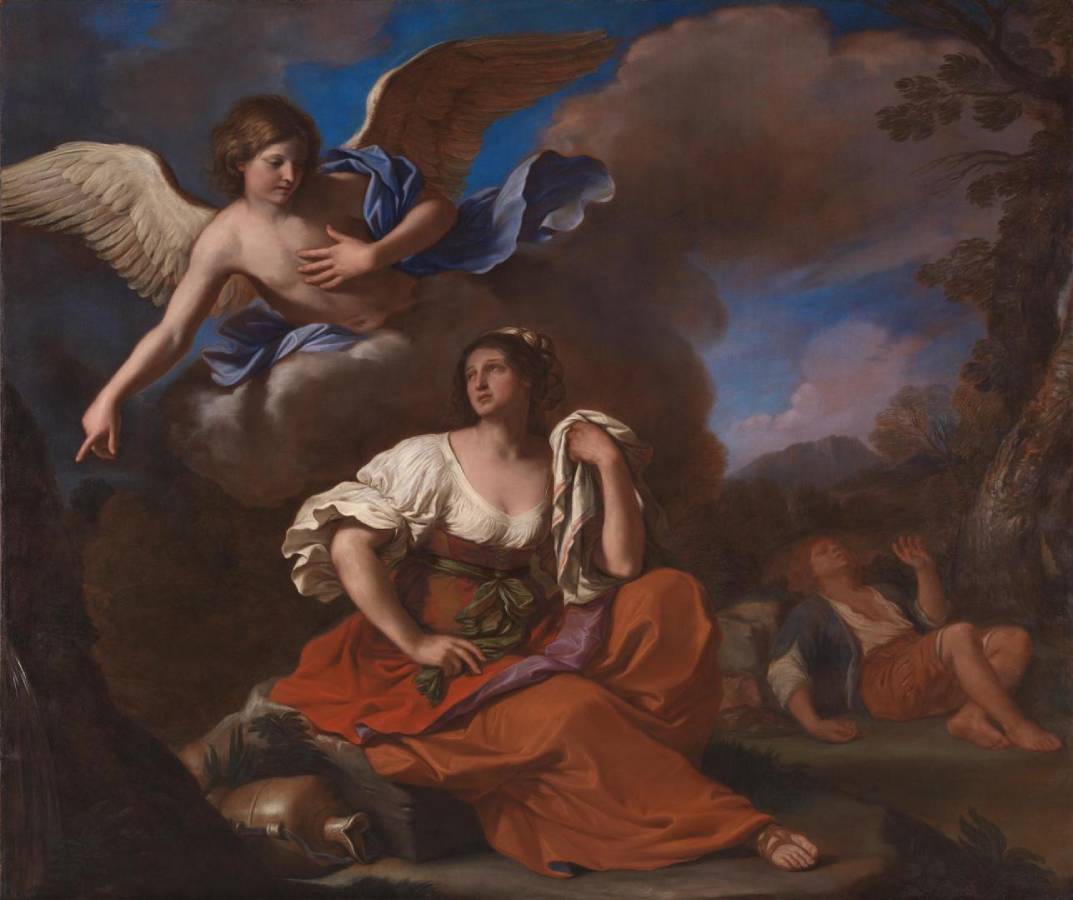Guercino (1591-1666)
Agar e Ismaele nel deserto confortati dall’angelo (The Angel appears to Hagar and Ishmael)
1652–1653
Oil on canvas, 193 x 229 cm
National Gallery, London
The story of Hagar and Ishmael is told in the Old Testament (Genesis 16 and 21). Although promised by God that he would have as many descendants as there are stars, Abraham was unable to have a child with his wife, Sara. She presented her Egyptian maidservant Hagar to her husband, who bore Abraham a son, Ishmael. Years later, the aged Sara miraculously conceived and gave birth to a son, Isaac. She then convinced her husband to banish Hagar and Ishmael to the wilderness, where their supplies ran out and they were left to die.
In this painting, Guercino shows the exiled pair on the brink of starvation, Hagar turning away from her son so she does not have to watch him die. As she weeps, an angel appears to show her a nearby water source – visible in the bottom left corner of the painting – thus saving their lives. Hagar’s anguish is the main focus of this painting as she sits, poised and dignified, in the centre of the composition. Her gleaming tears convey her intense sorrow, as Guercino presents us with a compassionate portrayal of human grief. An empty vessel lies on the ground near Hagar, a reference to her hardship in the desert.
We witness the moment Hagar has just opened her eyes and is about to be delivered from her terrible fate. She has turned to look at the angel who emerges from the clouds above her, gesturing towards the flowing water lower left. Behind Hagar, on the right, is Ishmael, who has been laid to rest by his mother under some ‘shrubs’ (represented by Guercino as a tree). Ishmael (and the landscape behind him) is painted more sketchily and appears slightly out of focus. His presence serves to remind us of the narrative while not distracting us from Hagar.
Guercino demonstrates his skill in modelling the human figure by suggesting Hagar’s form beneath her maidservant’s dress. He has carefully articulated the folds and fall of the different fabrics, giving Hagar a sense of presence and solidity. The texture of her loose, billowing sleeves contrasts with her laced apron, tied around her waist with a length of green cloth. Above her, the angel’s cloak twists around his shoulders and flutters out dramatically behind him, like that of the putto in Guercino’s earlier Cumaean Sibyl with a Putto. The warm colours of Hagar’s clothes contrast with the cool blue drapery of the angel as he points towards the water.
Probably commissioned in the second half of 1652, this picture is an example of Guercino’s late classicising style. The painting is listed in the artist’s Libro dei Conti, a meticulous account book kept by Guercino between 1629 and 1666 that records details of commissions, prices for paintings, and their dates. This reveals that the work was paid for in March 1653 by Pandolfo Savini of Siena. Guercino’s late style was greatly influenced by the monumental classicism of Guido Reni who, like Guercino, was active in Bologna until his death in 1642.
Sir Denis Mahon, who amassed the largest private collection of Italian Baroque paintings in the world, purchased this painting in 1948. Mahon made significant contributions to the study of seventeenth-century Italian painting and was a particularly great admirer of Guercino. (NG)
